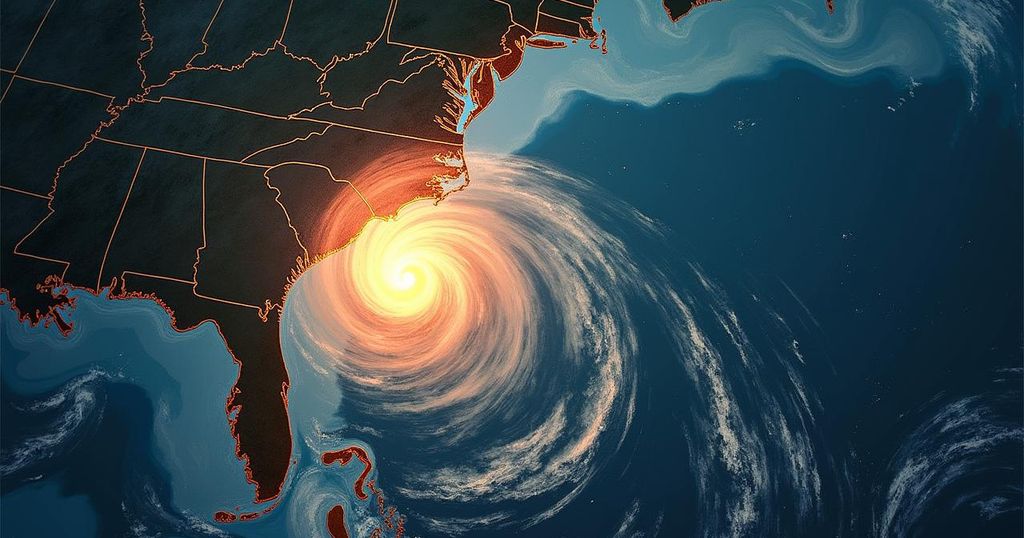Hurricane Helene: The Deadliest Hurricane Since Katrina, Alongside Current Atlantic Developments
Hurricane Helene has become the deadliest hurricane to hit the mainland U.S. since Katrina, claiming at least 180 lives. It now ranks as one of the three deadliest hurricanes in the U.S. in the last 50 years, with significant flooding contributing to its death toll. Meanwhile, concerns are rising over the possibility of new tropical disturbances forming in the Gulf of Mexico, as Hurricane Kirk shows potential for intensification in the Atlantic. Discussions about preparedness for hurricanes continue to be paramount given the increasing impacts of climate change.
Hurricane Helene has become the deadliest hurricane to strike the mainland United States since Hurricane Katrina, claiming at least 180 lives as reported by CNN on October 2. This toll surpasses the 156 fatalities caused by Hurricane Ian in 2022, marking Helene among the three deadliest hurricanes in the last 50 years in the U.S. Since 1969, the only hurricanes with a higher death toll than Helene are Katrina (2005) and Maria (2017). Helene’s death toll is primarily attributed to flash flooding that occurred following its landfall, reminiscent of Hurricane Camille’s devastation in 1969, which resulted in most of its 259 deaths primarily from flooding in the Appalachians, particularly in Virginia. The total death figures encompass both direct and indirect fatalities. Direct fatalities refer to those caused by winds, storm surge, and rain, whereas indirect deaths can arise from secondary consequences such as traffic accidents during evacuations or inadequate medical care due to power outages. For example, evaluations conducted in the wake of Hurricanes Katrina and Maria highlighted numerous indirect deaths. A study commissioned by the Puerto Rican government estimated an excess death range of between 2,658 and 3,290 in the aftermath of Maria, with 2,975 cited as Puerto Rico’s official death toll. Similarly, studies found evidence of excess deaths post-Katrina, with one research indicating 2,358 excess deaths in New Orleans six months after the hurricane’s landfall. In the meantime, meteorological observations are being made concerning the potential formation of a tropical disturbance in the Gulf of Mexico, triggered by a low-pressure area interacting with Tropical Depression 11-E in the Eastern Pacific and a stalled frontal system. Although the likelihood of this disturbance escalating into a damaging hurricane similar to Helene is low, it may contribute to considerable rainfall across the southern Gulf Coast and Florida. Currently, forecasts indicate a 0% chance of cyclone development in the upcoming two days, with a 40% probability over the next week. Additionally, Hurricane Kirk is demonstrating potential to reach Category 4 status while traversing the central Atlantic, away from land. On October 2, sustained winds of 85 mph were recorded with models suggesting increased chances of intensifying conditions in the coming days. Kirk’s trajectory suggests it will veer north and northeast, well away from coastal areas before transitioning into a post-tropical cyclone next week, potentially impacting northwestern Europe. Additionally, Tropical Depression 13, which formed in the eastern Atlantic, is expected to strengthen into Tropical Storm Leslie shortly. This storm is predicted to gradually increase in intensity over the next few days, potentially becoming the eighth hurricane of this Atlantic season. The occurrences of these storms underline the critical need for awareness regarding climate change and its implications on severe weather events. Understanding the dynamics of hurricane formation and tracking can significantly contribute to effective disaster preparedness and response.
This article discusses the impact of Hurricane Helene, detailing its death toll and comparing it with past hurricanes, notably Katrina and Maria. It also explores the potential formation of additional tropical disturbances in the Gulf of Mexico and the developments surrounding Hurricane Kirk and Tropical Depression 13, providing context on current meteorological activities and their implications for affected regions. These events highlight the increasing severity and frequency of hurricanes, stressing the importance of remaining vigilant as climate change continues to influence weather patterns.
In conclusion, Hurricane Helene’s catastrophic toll establishes it as a significant event in recent hurricane history, with its casualties surpassing those of Hurricane Ian and positioning it among the most lethal storms of the past half-century in the United States. The abstract implications of indirect fatalities underscore the long-lasting effects of such disasters, necessitating continued research and assessment. Additionally, the formation of other tropical disturbances, including Hurricane Kirk and Tropical Depression 13, indicates the ongoing hurricane season’s intensity, underscoring the importance of preparedness in facing such climate phenomena.
Original Source: yaleclimateconnections.org




Post Comment